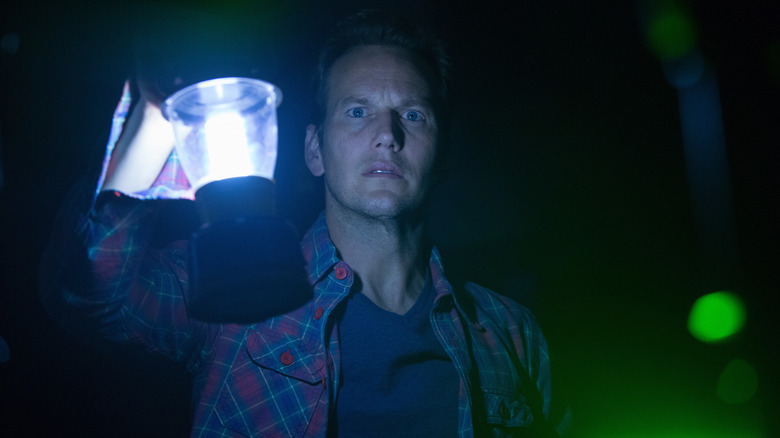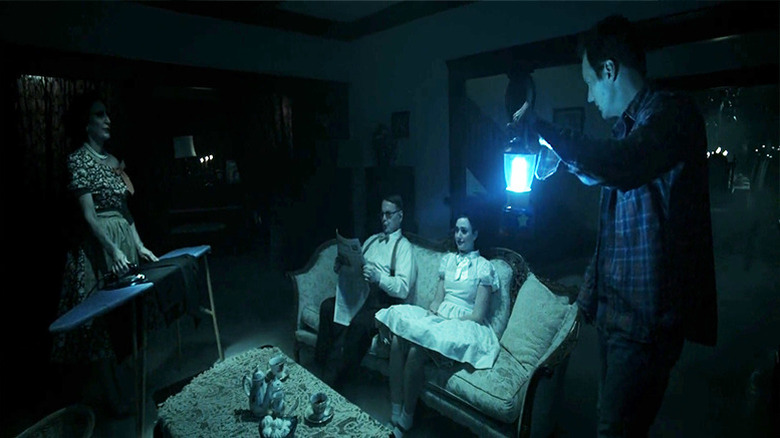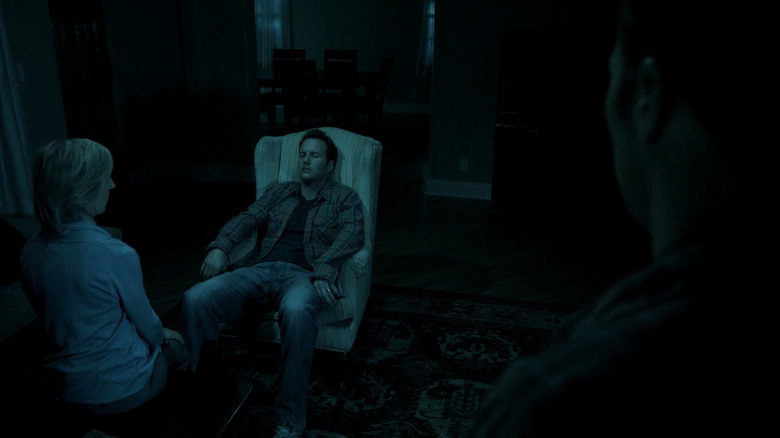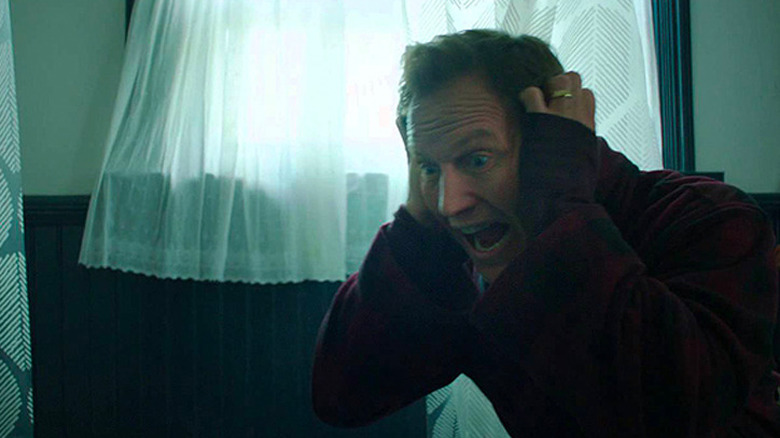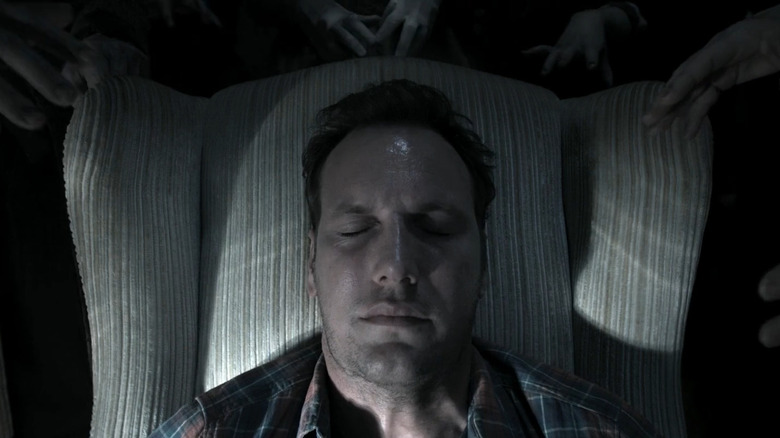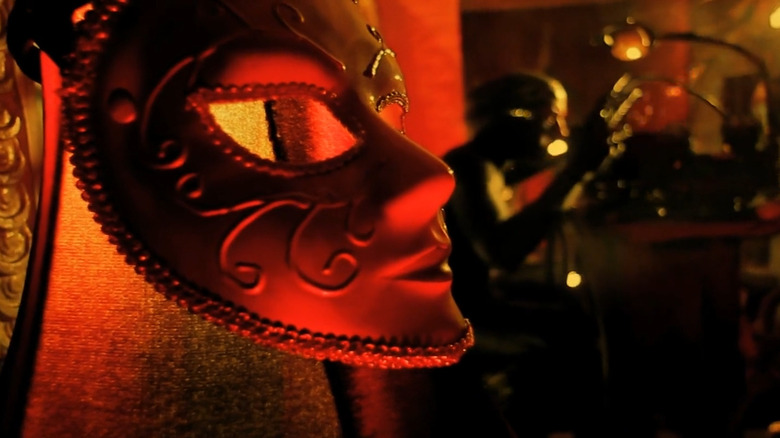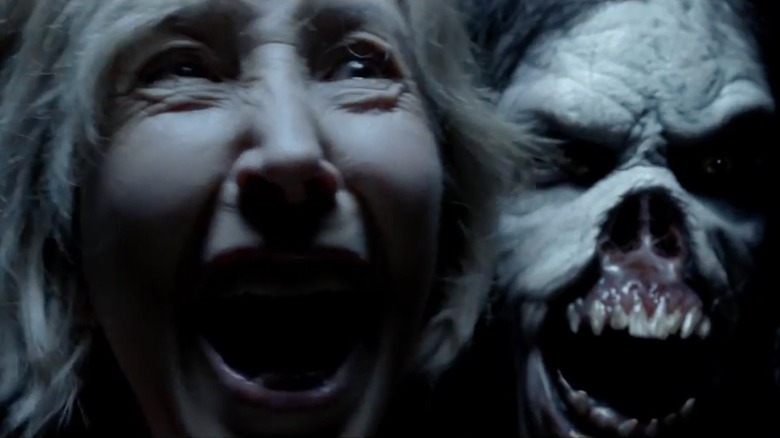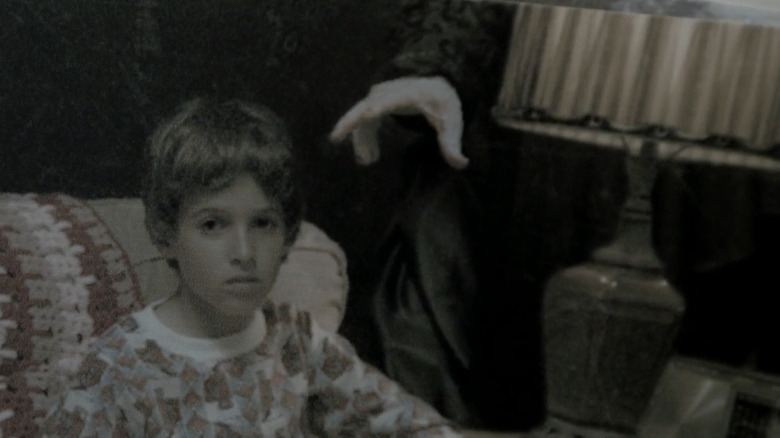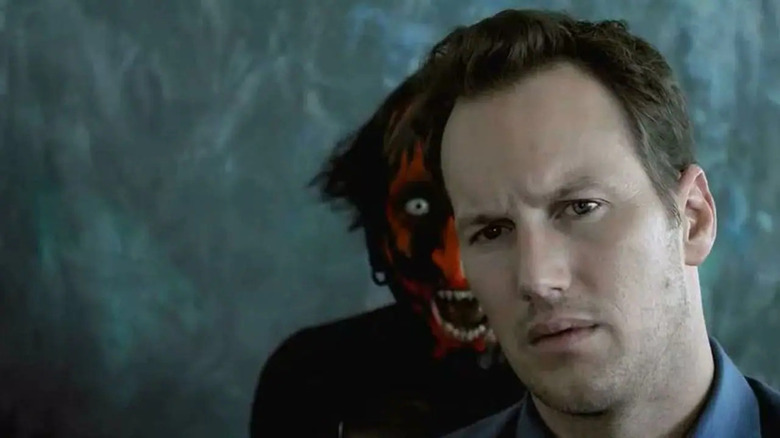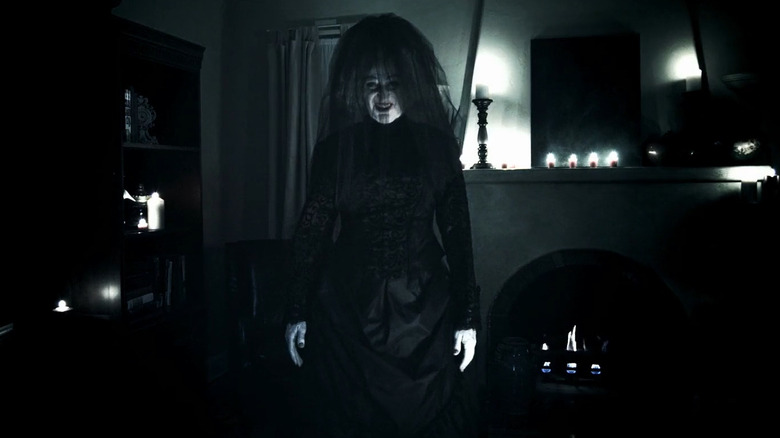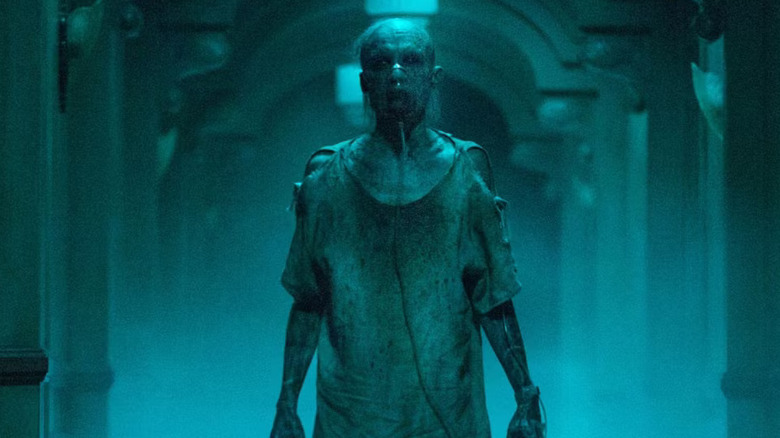The Further From Insidious Explained
Ever since its arrival in 2010, the "Insidious" franchise has proven itself to be a bastion of jump scares and intriguing worldbuilding. Spawned from the brains of James Wan and Leigh Whanell, the creators of "Saw," the series takes the ghost story in a modern and incredibly far-out direction.
Instead of the standard haunted house story, the two crafted a narrative that helped reinvent the wheel when it comes to ghosts and demons. In the "Insidious" universe, the threat isn't landlocked to a specific house, but rather a specific purpose, due largely in part to a supernatural realm known as the Further. This setting has served as a major plot device for the events of the film and its four sequels.
However, just in case any of you need a crash course or reintroduction for "Insidious: The Red Door," we've got you covered. So let our voice be your guide and keep a steady stride, because this is the Further from "Insidious" explained.
What is the Further?
The first "Insidious" film really takes its time when it comes to unveiling its true inner workings to the audience. At first, it positions itself as a standard haunted house film, complete with the classic trope of a family, the Lamberts, moving into a brand new home. As is par for the course for this genre, spooky things begin going bump in the night.
One of the family's children, Dalton (Ty Simpkins), has a supernatural encounter in the attic, leading to him entering a prolonged coma. This, plus a few other unsettling incidents lead to his parents, Josh (Patrick Wilson) and Renai (Rose Byrne), relocating the family once again. However, we eventually learn that it wasn't the house that was haunted, but rather Dalton himself. As psychic and paranormal investigator Elise Rainier (Lin Shaye) later explains, Dalton's coma is a result of his consciousness being trapped in a dimension known as the Further.
She goes on to elaborate that the Further serves as a sort of purgatory for the souls of the deceased. This includes a wide range of various supernatural entities, from the warped souls of dead humans to actual demonic entities. This makes getting lost in the Further incredibly dangerous and gives Dalton's situation a sense of urgency — the longer he is in the Further, the more likely the spirits are to do him harm.
How does one travel to the Further?
"Insidious" does a tremendous job of explaining the rules of the Further without being unnecessarily detailed. One aspect it doesn't neglect to explain, however, is how exactly someone travels to the Further in the first place. As Elise explains, Dalton possesses the ability to astral project his consciousness while he's sleeping, thereby leaving his own body and traveling to the Astral Plane.
The Cambridge Dictionary defines the Astral Plane as, "a place believed by some people to be where a person's spirit goes between dying and entering the spirit world." This helps explain the Further's purpose as a purgatory for various souls that can go to neither heaven nor hell. Dalton, being a young child, doesn't really understand what he's doing or how, meaning he is more susceptible to getting lost.
We also learn there are a few different ways to astral project, as it's eventually revealed that Josh can do it as well. In this case, however, as opposed to waiting for Josh to fall asleep, Elise opts to induce it via hypnosis. It's here that new dangers present themselves, specifically for people who wander too far into the Further.
How does the Further lead to possession?
Once "Insidious" has established the what and the how of the Further, it's very quick to explain the various dangers that it presents. Specifically, what can happen if someone who's left their body behind while astral projecting gets lost or stuck in Further and can't escape.
As previously mentioned, Dalton's coma is actually the result of his consciousness having drifted too far and gotten trapped in the Further. We say trapped and not stuck because, as we eventually see, Dalton has been chained up by a being known as the Lipstick-Face Demon (Joseph Bishara). This means that Dalton's body is now vacant and a prime possession target for the demon, as well as the Further's entire roster of malevolent entities.
However, while Dalton is able to reclaim his body, the same can't be said for Josh, who's taken over by a ghost known as the Bride in Black. This is revealed to us at the tail end of the film when Elise discovers his possession and, after snapping a picture of him, is strangled to death. "Insidious: Chapter 2" picks up immediately after this and shows just how destructive an evil spirit can be in a human host. Given the malicious nature of the Further's residents, it shouldn't be shocking that killing and torment seem to be high on their ghostly to-do lists.
Can the Further affect the waking world?
Considering how much damage the Further can do to anyone trapped within it, you might be wondering what it can do to those outside of its spectral limits. Well, as scary as this might be to say, you are likely in just as much danger outside of the Further as you are inside of it.
This particular threat begins slowly after Dalton is trapped in the Further following his astral projection mishap. With his body now abandoned, it has basically become a beacon for prospective possessions, basically creating an open invitation for various spooks to stop by the Lambert house. This includes the likes of the Lipstick-Face Demon, as well as a siege of other pale-faced ghouls and dead-eyed specters looking for a new home.
This occurrence is what helps facilitate many of the effective jump scares throughout the early scenes of "Insidious." It's through these brief and prolonged sequences we also get a sense of how much these entities can interact with the physical plane of existence. This includes entities popping up in the likes of attics, bedrooms, kitchens, and even inside of bedroom closets and drawers.
The visuals of the Further
The Further is fascinating to describe on a visual level as, given its function as a ghostly purgatory, it's always in flux in terms of its appearance. Its initial appearance tends to vary on the person who's going inside and from where they've begun astral projecting.
For example, when Josh is hypnotized in the first film, he begins in the living room and ventures through a distorted version of his own home. From there he enters the other areas of the Further, which can be molded by certain memories or by a certain entity. So when Josh goes to rescue Dalton from the Lipstick-Face Demon, we see the demon has his own space that it's appropriately red, just like it. This is also why Josh ends up seeing his old childhood memories leak into the Further, leading to a creepy confrontation with the Bride in Black (Philip Friedman).
Also, whenever the Bride in Black is taking center stage, the scene becomes predominantly dark, supplemented only by minimal lighting. Throw in a fair amount of fog and long ominous hallways and you can definitely understand why this place is purgatory. These little visual touches, bolstered by haunting music and very moody cinematography, help create a thoroughly creepy environment.
What is Elise's connection to the Further?
At the heart of the "Insidious" franchise is Elise Rainier, a paranormal investigator played by the incomparable Lin Shaye. Whereas the first two films and 2023's "Insidious: The Red Door" focus predominantly on the Lamberts, the third and fourth films serve as prequels, giving audiences more insight into Elise. These two films do a lot to supplement Elise's character, providing her with a haunting backstory as well as elaborating on her interesting profession.
In "Insidious: The Last Key," we discover that Elise has been dealing with the paranormal since her childhood, when she encountered a violent paranormal entity. In "Insidious: Chapter 3" we get to learn more about Elise's experience with the Further, having been pursued by the Bride in Black since meeting Josh Lambert. It's very clear that Elise's various brushes with the evils of the Further have scarred her, making her warnings towards the Lamberts in the first film more understandable.
As an added little twist, in "The Last Key," we see Elise and Melissa, the girl she's rescuing, open a door where they see Dalton Lambert. This means that Elise's meddling was what led Dalton to the Further in the first place, bringing everything full circle.
What is the Lambert family's connection to the Further?
The first "Insidious" focuses on the Lambert family — Josh and Renai, as well as their three kids, Dalton, Foster, and Cali — moving into a new home. However, shortly after their arrival, not only does their son Dalton fall into a deep coma, but supernatural phenomena begin occurring with greater frequency.
Josh's mother, Lorraine (Barbara Hershey), then reveals she's been experiencing some distressing nightmares about a red demon, leading to Elise being called in. It seems Josh, much like Dalton, at one time possessed the ability to astral project and had been nearly possessed by the Bride in Black. Following these childhood incidents, Lorraine opted to have Elise hypnotize Josh so that he couldn't remember he could travel into the Further. So Josh, with Elise's guidance, must now tap back into his once-forgotten abilities and rescue his son.
This results in, as previously mentioned, Dalton being saved, but Josh finally being possessed by the Bride in Black. However, thanks to Elise's help from beyond the grave, the Bride, as well as his ghostly mother Michelle, are vanquished, ending the Lamberts' collective nightmare. Josh and Dalton are then once again hypnotized to forget in order to quell any future run-ins with the evils of the Further.
What is the Lipstick-Face Demon?
We've mentioned this handsome fella a few times already, but now let's really discuss just who or, more accurately, what, the Lipstick-Face Demon is. While the "Insidious" movies maintain a revolving door when it comes to their respective main antagonists, the Lipstick-Face Demon is the closest to a mascot the series has. For a franchise with so much intriguing lore, its most iconic antagonist is the most elusive in terms of its origins.
However, while we aren't given any definitive backstory for the creature, we can definitely glean some things just based on his appearance and presentation. Going off of its horrific appearance — a muscular yet thin black body complete with a painted red face and piercing yellow eyes — this creature is far from human. It also boasts a set of mangled steel claws which it is seen sharpening while listening to the haunting sound of Tiny Tim's "Tiptoe Through the Tulips."
This makes it a bit of an outlier amongst the other ghostly residents of the further which are all predominantly human in their appearance. We can also deduce that the Lipstick-Face Demon particularly enjoys the suffering of children, given the ironic presence of puppets and dolls in its lair.
Who is the Bride in Black?
When it comes to iconic ghouls from the "Insidious" franchise, the Bride in Black certainly stands out as truly sinister. From her first moments on screen, you immediately get a clear sense of just how evil and dangerous she is. At first, all we're told is how she stalked a young Josh Lambert during his childhood due to his ability to astral project into the Further. It seems she was looking for a new body and, following the events of the first film, she finally succeeds in accomplishing that task. During his jaunt into the Further, Josh becomes trapped and the Bride in Black is able to take his body for a horrific joy ride.
It's in "Insidious: Chapter 2" that we learn that the bride isn't a woman at all, but a man, more specifically the ghost of a man named Parker "Marilyn" Crane (Tom Fitzpatrick). It seems Parker's unstable mother, Michelle Crane (Danielle Bisutti), really wanted a little girl, so much so that she forced Parker to assume the identity of one. This led Parker to a life of serial murder wherein he dressed as a bride in a black dress to avoid any police deduction. Parker finally met his demise at the conclusion of the second film, before appearing once again in the prequel, "Insidious: Chapter 3," as a secondary antagonist.
Who is the Man Who Can't Breathe?
"Insidious 3" is the first of the series to not focus on the Lambert family, instead revolving around a new character named Quinn Brenner (Stefanie Scott). After attempting to contact her deceased mother with Elise, Quinn soon finds herself the target of this grisly new threat known as the Man Who Can't Breathe (Michael Reid MacKay). We learn that the Man Who Can't Breathe is a spirit who feels robbed of a life, having died prematurely due to his illness. So now he goes after people like Quinn as an outlet for all of his ghostly anger, manifesting in some truly terrifying sequences.
Appearance-wise, the Man Who Can't Breathe wears a hospital breathing apparatus, as well as a tattered hospital gown as well. He also has gray and withered corpse-like skin, complete with bloodshot eyes and wispy hair on top of his very gaunt figure. It's far more simplistic of a design compared to the Lipstick-Face Demon and the Bride in Black, but is still effectively creepy.
If you are the kind to be disturbed or creeped out by medical horror, then this will definitely get under your skin in the best possible way. The Man Who Can't Breathe only serves as the antagonist for one film, but definitely succeeds at leaving a lasting impact.
